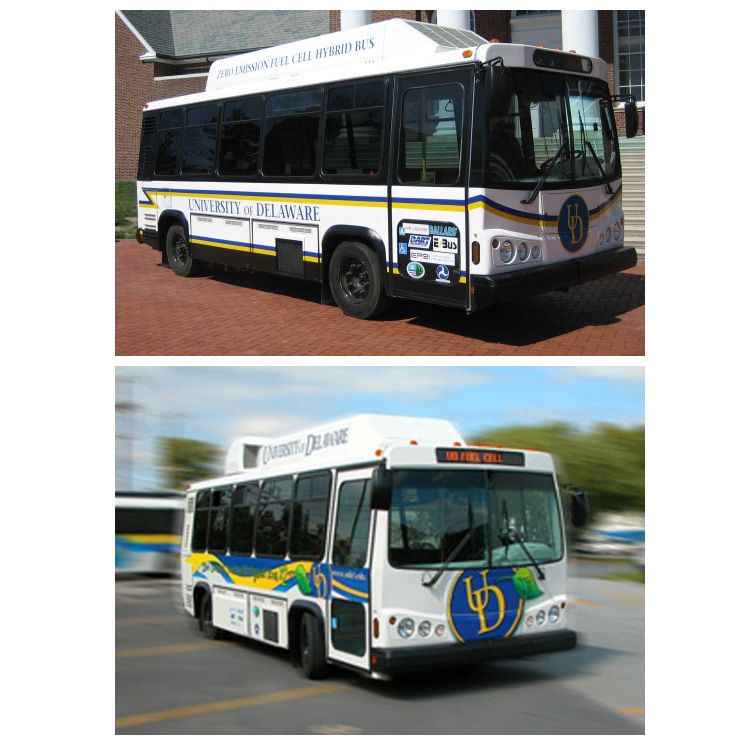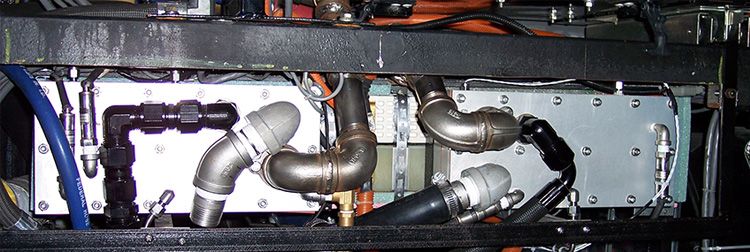Simulating Fuel Cell Hybrid Bus Technology at the University of Delaware
By Ajay K. Prasad, University of Delaware
The fuel cell hybrid bus (FCHB) that shuttles University of Delaware students and faculty across campus on the 6-mile Express Route serves as a highly visible demonstration of the power and benefits of hydrogen fuel cell technology. The bus is zero-emission, and much quieter than its diesel counterparts; it can be refueled and maintained at a single location, reducing infrastructure costs; and its series-hybrid design makes it particularly effective for the start-and-stop driving and relatively low speeds on urban bus routes.
Using MATLAB® and Simulink®, University of Delaware researchers modeled the FCHB, analyzed data from its many onboard sensors, improved its power management strategy, and gained key insights into fuel cell bus design optimization.
Simulink enables us to answer design questions that would be extraordinarily expensive to answer via trial-and-error hardware iterations. For example, we run simulations that show us how the bus will perform if we double or triple the size of the fuel cell stack. Other simulations show what would happen if we reduced the 4000 pounds of batteries on board to 2000 pounds. We simulate changes to the chassis and the weight distribution of the entire vehicle. By analyzing the results of these simulations, we can see if a certain design is more efficient, if it consumes less hydrogen per mile traveled, or if it reduces stress on the batteries. We can then share our findings with the bus manufacturer, Ebus, who uses them to improve future designs.
A Multiyear, Multibus Research Effort
Funded by the Federal Transit Administration, the FCHB program was started in 2005 to develop and demonstrate fuel cell buses and hydrogen refueling stations in Delaware. The first fuel cell bus went into operation in 2007; the second, in 2009 (Figure 1). The program will ultimately include four buses, each incorporating design improvements and lessons learned from its predecessor.
What sets the University of Delaware FCHB apart from other fuel cell buses being tested around the world is its relatively low cost. Our buses cost about 50% less than comparably sized fuel cell buses currently in operation, in large part because we use a hard series-hybrid design. In this design, the fuel cell is used primarily to recharge the battery, not to directly drive the vehicle, enabling us to use a much smaller—and less expensive—fuel cell. The fuel cell stack in our first bus, for example, delivers just 20 kW gross power, whereas comparable buses use stacks 5 to 10 times larger. A 20 kW (27-horsepower) fuel cell delivers approximately the same amount of power as a lawn tractor engine, yet it is capable of transporting dozens of people around campus.
The fuel cells, in combination with batteries in a series-hybrid design, have proven fully capable of powering our 22-foot (6.7 m)-long buses carrying 22 seated and 10 standing passengers. The buses are refueled at a hydrogen station near campus operated by Air Liquide. When fully fueled and charged, the buses have a range of 180 miles (290 km).
Modeling the First Bus
We modeled the bus and all its components using a Simulink library developed by the Electric Power Research Institute (EPRI), one of our consortium partners. The LFM (Light, Fast, and Modifiable) library is flexible and easily applied to a variety of hybrid vehicle platforms. Using the design specifications provided by Ebus, we set up baseline parameters for the main model components, including the chassis, transmission, traction motor, batteries, fuel cell system, and power combiner (Figure 2). In addition, we modeled the balance of the plant, which incorporates all the auxiliary devices required by the fuel cell stack, including the hydrogen recirculation pump, air compressor, and coolant pump. Each powertrain component has about six inputs, and the complete model produces more than 30 outputs, including the state-of-charge of the batteries, fuel cell output, hydrogen consumption, and regenerative braking power. The model is complex and sophisticated, but with each component captured as a Simulink block, it is easy to manage all the subsystems in the overall system.
To validate our model, we instrumented the bus with a GPS receiver and more than a dozen sensors that measure voltage, current, temperature, flow rates, and humidity at key onboard locations on each trip. We then simulated the same drive cycle in Simulink and compared the measured data with the simulation results. Our model's predictions matched the vehicle data to within 5%, which gives us confidence that the model can now be used as a reliable design tool. In addition, we analyzed the measured data in MATLAB to understand how performance varied seasonally and day by day.
Improving the Power Management Strategy
In a hybrid vehicle, the power management strategy determines which onboard power generators are active at any given time and at what rate they are producing power. Our first bus came with a fairly rudimentary power management strategy. When the battery state-of-charge dropped below 65%, the system activated the fuel cell to begin recharging the battery. If the system requested maximum power immediately, the fuel cell delivered, but it did so inefficiently because it was outside its optimal operating region. One of our first goals was to improve upon this strategy.
We used MATLAB and Simulink to evaluate power management strategies that incorporate knowledge of the planned route to keep the fuel cell stack operating more consistently at its peak efficiency point. With MATLAB it is easy to script several simulation runs and modify the strategy or other aspects of the model in each run. We used this approach to identify a strategy that yielded the best combination of performance and efficiency. We then implemented the strategy by updating the onboard programmable logic controller (PLC). Simulations enabled us to identify the optimal time to activate the fuel cell within its daily drive cycle so that the combined output of the fuel cell and battery would meet the vehicle's needs for the remainder of the trip, thereby exercising the nickel-cadmium battery and conserving hydrogen.
Improvements on the Second Bus
Sensitivity analysis played a vital role in helping us identify ways to improve performance. Each major component in the powertrain has parameters that can potentially be modified in future designs. We developed MATLAB scripts that modify these parameters in the Simulink model programmatically, sweeping them from -30% to +30% of their current values. We then ran these scripts automatically for multiple parameters. When the simulations completed, we used MATLAB to analyze the vast amount of data we had accumulated and identify and plot the parameters that most affect performance.
When the bus manufacturer began designing and building the second bus in the series, we had already learned a great deal about key performance parameters, fuel cell and battery dynamics, and how the fuel cell and batteries operate throughout the drive cycle. Our simulations helped to validate the bus manufacturer's decision to double the fuel cell stack size to approximately 40 kW (Figure 3).
While that change would make it possible to reduce battery capacity, we decided to use the same nickel-cadmium battery package to avoid the redesign a new package would have required. Doubling the fuel cell stack increased the average operating speed of the bus from 18 mph to 35 mph, which matched the results predicted by our Simulink simulations. The change also enabled the bus to complete more demanding transit routes and to use roads that require higher minimum speeds.
Our buses are equipped with an innovative cell voltage monitoring (CVM) system designed and fabricated at the University of Delaware. The system enables us to learn more about the fuel cell stack at a very detailed level because it can detect damagingly low or high voltages on the more than 100 individual cells in the stack. The CVM system scans and records these voltages once every second. We can monitor the results in real time via a cellular link that transmits data to a server in the lab, or analyze the recorded measurements later, where MATLAB is the software of choice for data acquisition, analysis, and visualization.
Our Third Bus and Beyond
The third bus incorporates significant design changes. Like the second bus, it will have a 40 kW fuel cell stack, but we are switching from nickel-cadmium batteries to lithium-ion, which will reduce the weight of the battery package from 4000 pounds to about 1500 pounds. Lithiumion batteries have an excellent lifespan and can be charged and discharged faster and more frequently, which will enable us to explore new power management strategies in Simulink. With the increased performance, the powertrain will be able to drive a larger bus at higher sustained speeds; buses three and four will be 30 feet long and will carry up to 10 more passengers than the 22-foot buses.
As part of the ongoing research, one of our graduate students recently completed a thesis in which he explored the use of supercapacitors in a blended storage system with fuel cells and batteries. He modeled the supercapacitors in Simulink and incorporated them into our FCHB model to simulate and test advanced power management strategies that exploit the supercapacitor's rapid charge and discharge characteristics. This research is an excellent example of the value of Simulink in this field; it would be prohibitively expensive and time-consuming to explore these kinds of ideas in real hardware. Simulink not only makes exploration possible, but it produces results that are very reliable. That graduate student has since been employed with a fuel cell bus company in California, where he is applying the experience he gained on the FCHB program.
As a researcher and faculty member, I find the FCHB program very gratifying. Our graduate students have done outstanding work, and when we see the bus going across campus we know how the simulations have contributed significantly to improve its performance. It is not often that an academic exercise yields such immediate and practical value.
FCHB Basics
Hydrogen fuel cells are two to three times more efficient than combustion engines. As they become more widely available, they will reduce our dependence on fossil fuels. In a fuel cell, hydrogen and oxygen are combined in an electrochemical reaction that produces electricity and, as a byproduct, water. (We have had this water analyzed, and found that it is pure enough to drink.) The other onboard power source is a nickel-cadmium battery pack, which is charged overnight. The battery pack provides traction power to the wheels. It also accepts regenerative power from the wheels during braking. This zero-emissions hybrid drive system is much cleaner and quieter than diesel engines and has no soot or carcinogens in its exhaust.
Published 2011 - 91895v00


